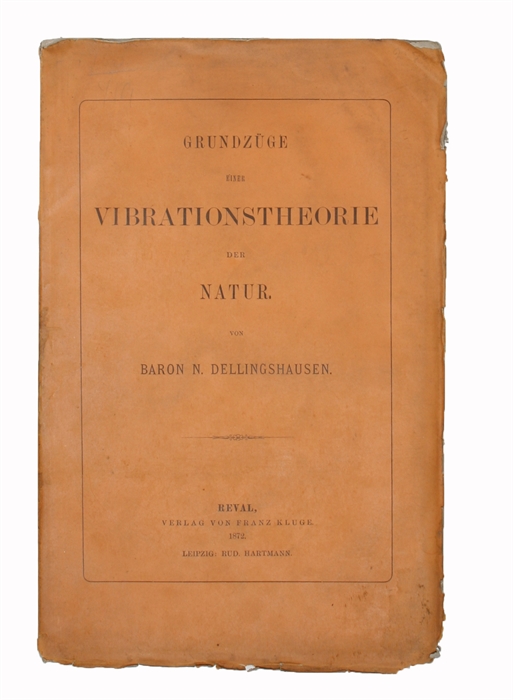THE PRECURSER OF THE THEORY OF WAVE-MECHANICS
DELLINGSHAUSEN, BARON N. (NICOLAI VON).
Grundzüge einer Vibrationstheorie der Natur.
Reval, Kluge, 1872. 8vo. Completely uncut and unopened in the original printed orange wrappers. A bit of soiling to wrappers, minor lacks to capitals, a small tear to the spine and a tear to the back wrapper - no loss. (10), 405, (1) pp.
Uncommon first edition of Dellingshausen's noteworthy main work, which constitutes one of the first attempts to prove the identity of particles and waves, thus anticipating by many decades a theory that eventually led to the creation of wave-mechanics, by many considered the single most important contribution to theoretical physics in the twentieth century.
The honour of founding wave-mechanics befalls Louis de Broglie, who won the Nobel Prize for it in 1929. With his PhD-thesis of 1924, which inspired Einstein, who supported his theory of the wave-particle duality of matter, De Broglie had set the basis for one of the greatest innovations of the 20th century. It is, however, often forgotten - or not known - that a few solid minds had actually had theories along the same lines, long before de Broglie writes his seminal PhD-thesis. The first and most well-founded of these seems to be Dellingshausen, who presents his theory in full in his great main work "Grundzüge einer Vibrationstheorie der Natur".
"Before we analyze Louis de Broglie's decisive contributions to the conceptual development of quantum mechanics and, in particular, his introduction of what is often called "matter waves", we shall ask ourselves whether - as it has so often occurred with great innovations in science - his ideas had not been anticipated, at least in part, by speculative thinkers in the past. Because of his optical-mechanical analogy Hamilton is often regarded as a direct precursor of de Broglie's hypothesis. This, however, is only partially true [...] Hamilton's interest, it is clear, lay wholly in the formal-mathematical aspects and not in the problem of the physical nature of light.
There were in the nineteenth century, however, some unorthodox thinkers who maintained, whether on physical or philosophical grounds, the ultimate identity between particles and waves. One of the most eloquent proponents of these ideas was Baron Nicolai Dellingshausen. After studying physics at the University of Dorpat, Leipzig, and Heidelberg, he returned to his Baltic estate and wrote a number of interesting studies on physics while administering his lands and farms. His major work, an enlarged version of an earlier essay, was published in 1872 under the title "Grundzüge einer Vibrationstheorie der Natur". Basing his ideas on the cartesian conception of extension as the chief characteristic of matter and on the kinetic theory of heat which reduced heat to motion, Dellingshausen identified atoms with standing waves and interpreted motion of particles as a vibrational process. According to his doctrine bodies are merely "Extended centers of vibrational motions" and the "nature of matter is extension in motion." (Jammer, pp. 239-40).
Order-nr.: 46544

